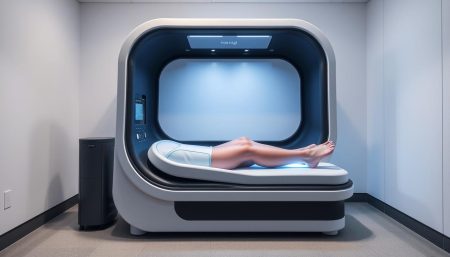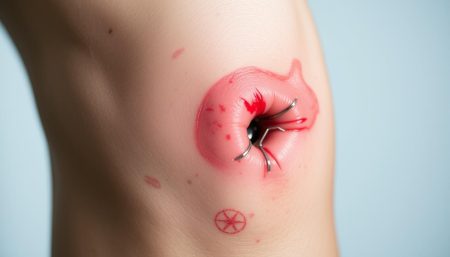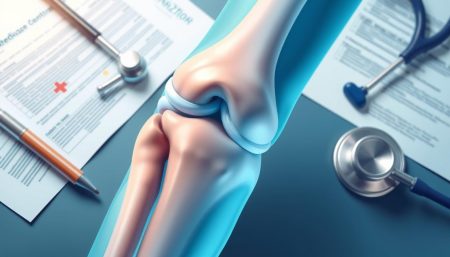When you choose a total knee replacement for pain-free mobility, you might face unexpected pain. This pain, often surprising and worrying, makes many question their surgery’s success. It’s a common concern for those who’ve had the surgery.
Many people have gone through surgery hoping to end chronic pain. But, they find new pain behind the knee. Knowing why this happens helps you feel more confident in your recovery. It prepares you for the challenges ahead.
Swelling, mechanical problems, or healing issues can cause postoperative knee pain. We need to understand these reasons with care. Our goal is to help you feel less alone in your journey.
This article aims to guide you through the tough times after knee surgery. We want to offer hope and support during this difficult period.
Understanding Knee Replacement Surgery
Knee replacement surgery, also known as total knee arthroplasty, is a major medical procedure. It aims to improve life quality by fixing severe knee pain and mobility issues. This section will cover the surgery and what to expect for recovery and pain management.
The Basics of Total Knee Arthroplasty
Total knee arthroplasty removes damaged knee parts and replaces them with artificial ones. It’s for those with severe arthritis or knee injuries that other treatments can’t fix. Knowing the surgery helps patients prepare for the recovery, including managing pain.
Knee Replacement Surgery Goals and Expectations
The main goal is to make the knee work better and reduce pain. This helps patients do daily tasks more easily. It’s key to have clear expectations about recovery and pain management.
Patients should expect a recovery that includes physical therapy and a pain plan. They should also know when they can go back to normal activities. Being ready and aware helps a lot in the recovery process.
Immediate Postoperative Pain: What to Expect
Feeling postoperative knee pain is common after knee replacement surgery. This pain is part of the healing process. Knowing what to expect and how to manage it is key for recovery. We’ll look at the usual pain levels, how long they last, and how to handle them during knee replacement recovery.
Right after surgery, patients often feel sharp pain as the anesthesia fades. Doctors use special medicines to help manage this pain. These medicines help with recovery. Here are some common steps to manage pain right after surgery:
- Administration of analgesics and anti-inflammatory medications
- Use of ice packs to reduce swelling and pain
- Gentle physical therapy exercises to improve mobility and reduce stiffness
- Frequent monitoring and adjustment of pain management protocols based on patient feedback
Knee replacement side effects include swelling, stiffness, and bruising. These symptoms are usually short-lived but important for healing. It’s important to talk to your doctor about any ongoing or unusual symptoms.
“Effective pain management in the immediate postoperative phase not only enhances comfort but can also significantly impact the overall outcome of the surgery.”
To understand postoperative care better, let’s compare different pain management methods:
| Intervention | Benefits | Risks |
|---|---|---|
| Medications | Quick pain relief | Potential side effects depending on the drug used |
| Ice Therapy | Reduces swelling and numbs pain | Limited duration of effectiveness |
| Physical Therapy | Promotes healing through improved circulation and movement | May be painful initially |
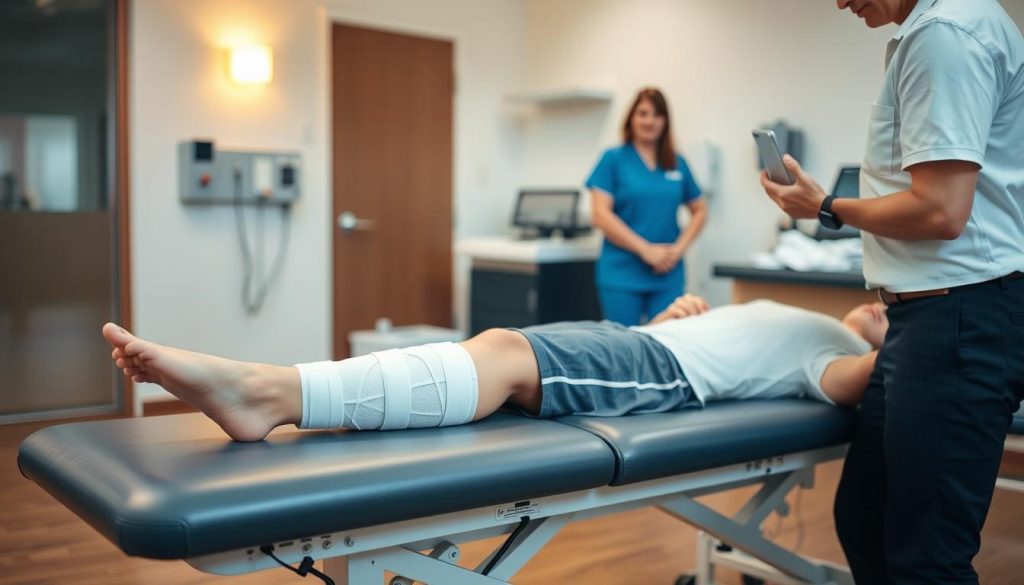
Managing postoperative knee pain well is key for a smooth recovery. Following the pain management and rehabilitation plan helps patients get back to their daily life quickly and safely. By being informed and actively involved in recovery, patients can improve their healing and regain mobility faster.
What causes pain behind knee after total knee replacement
Many patients worry about pain behind the knee after total knee replacement surgery. This section will look at common reasons for this pain. It aims to help patients and caregivers understand complications of knee replacement surgery and typical knee replacement side effects.
Common Post-Surgical Causes of Knee Pain
Postoperative knee pain can come from several sources. These include inflammation, joint misalignment, and nerve damage during surgery. Knowing these causes is key to managing symptoms and avoiding long-term problems.
Identifying Pain Triggers After Surgery
It’s important to know what makes knee pain worse after surgery. Things like too much activity, not enough rehab, or existing conditions can make pain worse. Finding out what triggers pain helps create a better pain management and rehab plan for each patient.
| Trigger | Impact on Postoperative Knee Pain | Suggested Management Approach |
|---|---|---|
| Physical Overexertion | Increases swelling and pain | Gentle exercises, adequate rest |
| Inadequate Rehabilitation | Slows recovery, increases risk of stiffness | Follow prescribed physiotherapy regimen |
| Pre-existing Conditions | May exacerbate postoperative pain | Consultation with a specialist for tailored management |
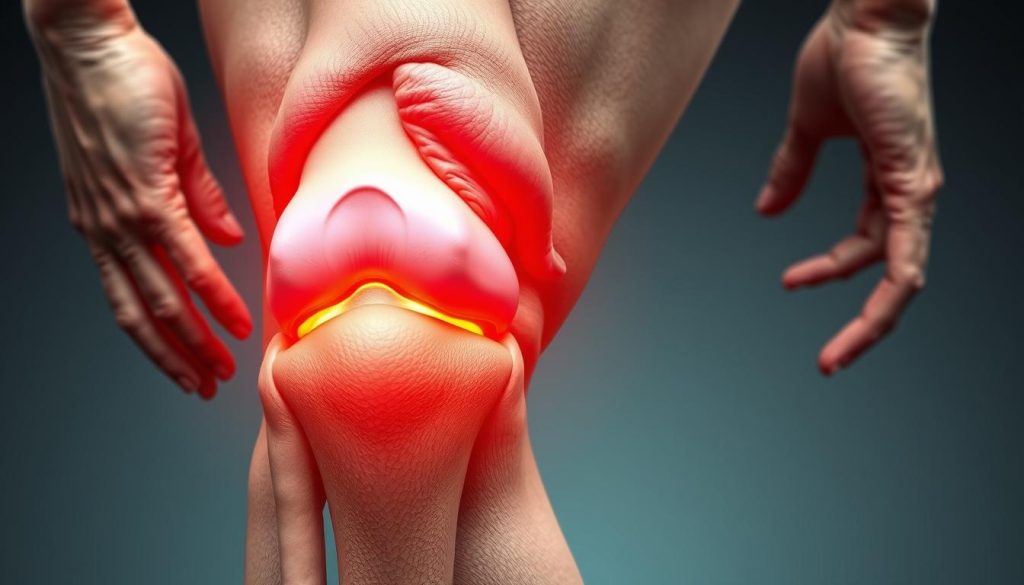
Knee Replacement Complications That Can Cause Pain
Knee replacement surgeries are usually successful. But, they can have complications that affect recovery and comfort. It’s important for patients to know about these possible issues.
Recognizing Signs of Infection
Infection is a big risk after knee replacement. It can cause more pain, swelling, and a longer recovery. Look out for redness, unusual discharge, fever, and warmth around the knee.
Seeing a doctor right away is key to treating these symptoms.
Prosthetic Issues and Mechanical Failures
Problems with the prosthetic knee can also cause pain. These issues might come from a bad fit, wear and tear, or mechanical problems.
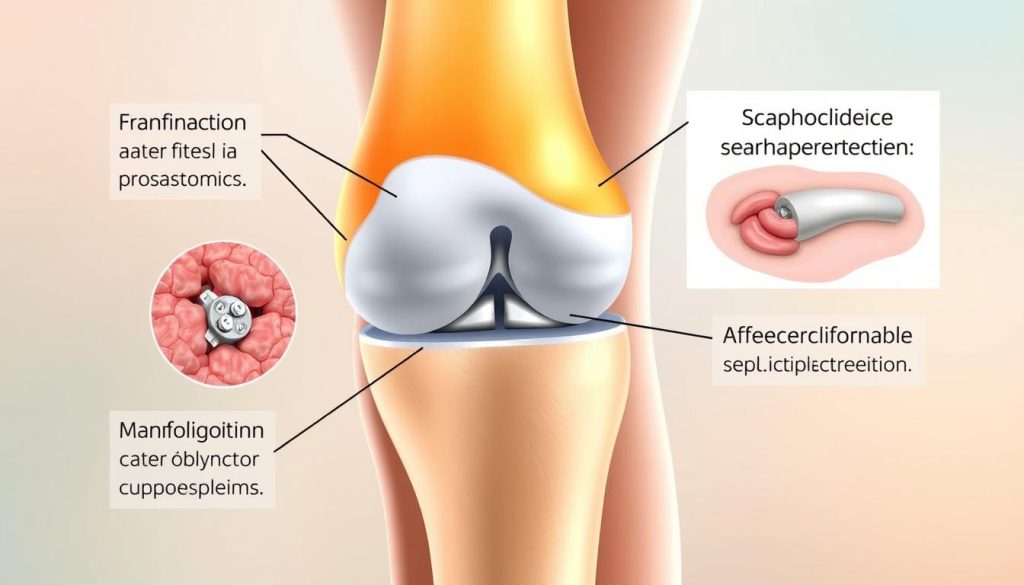
Getting a quick diagnosis and the right treatment is important for these mechanical issues.
| Complication Type | Symptoms | Recommended Actions |
|---|---|---|
| Infection | Redness, discharge, fever, swelling | Seek immediate medical care; antibiotics or additional surgery might be required |
| Prosthetic Issues | Pain during movement, instability when walking | Revision surgery might be necessary based on severity |
| Mechanical Failures | Abnormal sounds from the knee, acute pain during movement | Immediate consultation with an orthopedic specialist |
Knowing about these complications helps patients get the right care. This ensures a good recovery and long-term success of the knee replacement.
Managing Knee Pain After Surgery
Managing pain after knee surgery is key. Good strategies can make recovery better and outcomes better.
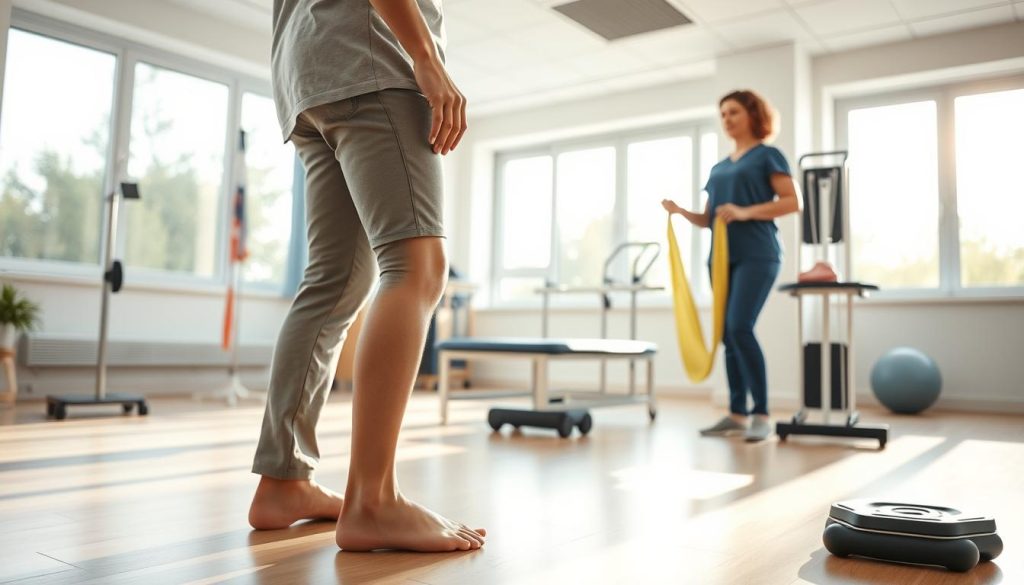
For knee replacement rehabilitation, a mix of medicine and non-medicine methods is best. Talk to your doctor about what pain relief options are right for you. This ensures you get the best care for your needs.
Medicine is a big part of knee arthroplasty pain management. Doctors might give you pain relievers like NSAIDs or opioids for a short time. Always follow your doctor’s advice to avoid side effects and addiction.
| Pain Management Technique | Benefits | Considerations |
|---|---|---|
| NSAIDs | Reduces inflammation and manages mild to moderate pain | Monitor for gastrointestinal upset |
| Opioids | Effective for severe pain | Use strictly under physician guidance to avoid dependency |
| Physical Therapy | Promotes movement and strength | Begin gently and increase intensity as approved by a therapist |
| Ice and Elevation | Decreases swelling and pain | Use intermittently for 20-minute periods |
Physical therapy is also vital for knee replacement rehabilitation. A physical therapist can help you with exercises. These exercises help your knee work better and reduce pain.
Changing your lifestyle also helps with knee pain after surgery. Eating well, staying at a healthy weight, and not smoking or drinking too much can help.
Every person’s recovery is different. Focusing on knee arthroplasty pain management helps you feel better faster. It also helps you get back to enjoying life sooner.
Knee Replacement Rehabilitation Techniques
After knee surgery, many patients follow a detailed knee replacement rehabilitation plan. This is key for managing knee pain after surgery and improving mobility. Good rehab techniques help patients recover faster and regain knee strength and function.
Rehabilitation is key to successful recovery and long-term outcomes following a knee replacement.
There are several important techniques in rehab. Using them well can reduce pain and speed up recovery.
- Physical therapy: Tailored exercises to restore movement and strengthen the knee.
- Hydrotherapy: Utilizing water resistance to improve joint function without undue stress.
- Assistive devices training: Learning to use walkers or crutches for optimal support.
- Pain management education: Techniques for managing knee pain after surgery including medication, ice, and elevation.
- Initial mobilization: Early movement to prevent stiffness and increase circulation.
- Strength training: Focused exercises to rebuild muscle and support the knee joint.
- Flexibility exercises: Stretching to maintain tissue elasticity and motion range.
| Technique | Purpose | Benefit |
|---|---|---|
| Physical Therapy | Restore movement, improve strength | Accelerates recovery process |
| Hydrotherapy | Enhance joint function with minimal stress | Reduces risk of strain injuries |
| Assistive Device Training | Provide support during limited mobility | Ensures safe movement post-surgery |
| Pain Management Education | Teach effective pain relief methods | Empowers patients in knee pain management |
Each rehab technique is customized for each patient’s needs. This ensures the best outcomes for their condition. By participating in knee replacement rehabilitation, patients not only recover faster but also improve their knee’s long-term function.
Postoperative Knee Pain: Evaluating Severity and Duration
Understanding how long and how bad postoperative knee pain is is key to managing it well. After a knee replacement, patients often feel pain, which is normal. But, it’s important to know when the pain is not usual.
This part talks about different levels of pain and what to expect during recovery. Each stage of healing brings its own level of discomfort. With the right care, this pain should get better as the knee heals.
Every patient’s pain threshold and recovery rate vary. It’s vital to openly communicate any concerns regarding pain with healthcare providers to tailor the best pain management strategies.
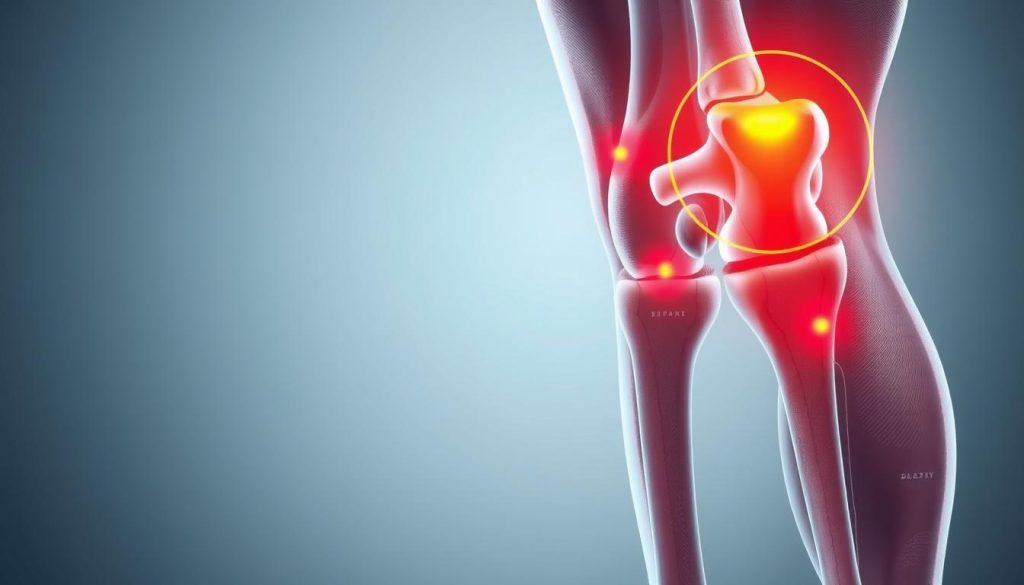
- Pain immediately after surgery — generally managed with medications and gradually lessens within the first few days.
- Mild to moderate pain during the first few weeks — usual during physical therapy sessions.
- Intermittent pain during recovery — can occur unexpectedly but should lessen both in frequency and intensity over time.
Consistent and unrelenting pain, on the other hand, might indicate possible complications. It is imperative for patients to monitor their pain levels and report any irregularities.
| Week Post-Surgery | Expected Pain Level | Notes |
|---|---|---|
| 1-2 | High | Direct postoperative period, pain managed with prescribed medications |
| 3-6 | Moderate | Pain during physical therapy as motion increases, managed with intermittent medication |
| 7-12 | Low to Moderate | Decreasing pain, occasional flare-ups, continued monitoring essential |
In conclusion, knowing about postoperative knee pain is important. It helps manage pain after surgery well. This approach makes recovery smoother and reduces the risk of long-term problems.
Long-Term Risks: Understanding Knee Replacement Side Effects
Knee replacement surgery is usually safe and helps with severe knee pain and mobility issues. But, it’s important to know about long-term risks. This section talks about chronic pain and how lifestyle affects knee replacement surgery outcomes.
Chronic Pain and How to Address It
Chronic pain is a side effect for some after knee replacement surgery. It can be a constant ache or sharp pain in the knee area. To deal with it, doctors use medicine, physical therapy, and sometimes change the prosthetic parts.
It’s key for patients to keep up with doctor visits to manage chronic pain well.
Lifestyle Factors Influencing Long-term Outcomes
What you do in your daily life affects how well knee replacement surgery works. It can make things better or worse. Important factors include:
- Physical activity: Doing regular, gentle exercises helps keep the joint and muscles strong. This supports the knee implant’s stability and life span.
- Weight management: Being at a healthy weight lessens stress on the knee. This lowers the chance of problems and keeps the joint healthy.
- Diet: Eating a diet full of vitamins and minerals helps bone health. It also speeds up recovery and keeps you feeling good.
Telling patients about knee replacement surgery risks and how to stay healthy is very important. It’s key to keep seeing doctors and make lifestyle changes to avoid problems and get better faster.
The Role of Physical Therapy in Knee Replacement Recovery
Physical therapy is key to a successful knee replacement recovery. It offers exercises and strategies to reduce pain and improve mobility. It’s essential for managing knee pain after surgery and speeding up the recovery process.
Designing a Custom Rehabilitation Plan
Every patient’s recovery path is different. That’s why physical therapists create personalized plans. These plans aim to reduce knee pain and help the knee recover faster.
Key Exercises for Optimal Knee Function
Good physical therapy includes specific exercises for strength, flexibility, and endurance. These exercises support knee replacement recovery. Here are some important ones:
- Leg Raises: These strengthen the quadriceps without putting too much strain on the knee.
- Knee Bends: These gentle exercises increase the knee’s range of motion.
- Walking: Starting with short walks helps improve circulation and mobility.
Doing these exercises with a professional’s guidance is important. It ensures the best recovery and helps manage knee pain after surgery.
Medication and Knee Arthroplasty Pain Management
Managing pain after knee surgery is key for a smooth recovery. Different medicines help with this, each suited for different needs. Knowing about these options helps patients and their caregivers during the healing journey.
Non-steroidal anti-inflammatory drugs (NSAIDs) and acetaminophen are often first choices. They help reduce swelling and ease pain. For more intense pain, stronger drugs like opioids might be used. But, opioids should be used carefully because of the risk of addiction and side effects.
Using a mix of pain relief methods can lead to better results. This way, we can use fewer opioids, which lowers the chance of knee replacement complications. Good pain management also includes local anesthetics and regional blocks. These methods target pain without causing widespread side effects.
| Medication Type | Benefits | Risks |
|---|---|---|
| NSAIDs | Reduces inflammation, alleviates pain | Gastrointestinal issues, cardiovascular risks |
| Acetaminophen | Effective for mild to moderate pain | Liver toxicity with overdose |
| Opioids | Effective for severe pain | Potential for dependence, side effects |
| Local Anesthetics | Localized pain control | Temporary numbness, risk of infection |
| Regional Blocks | Extended pain relief post-surgery | Nerve damage, ineffectiveness in some cases |
Choosing the right medicine should be done with a doctor’s help. They consider the patient’s health, the surgery’s extent, and how well they can handle certain drugs.
While medicines are important, other methods also play a big role. Physical therapy, healthy eating, and learning about pain management are all key for a good recovery.
When to Seek Help: Red Flags in Recovery
After knee replacement surgery, knowing what to expect and watching for complications of knee replacement surgery is key. Spotting serious side effects early can prevent long-term health problems.
Identifying Abnormal Pain and Symptoms
Some pain and discomfort are normal after knee surgery. But, certain signs could mean serious issues. Look out for severe pain, swelling, redness, or discharge from the incision site.
Keep an eye on your recovery and note any unusual changes. These could be signs of complications.
How to Communicate Effectively with Your Healthcare Provider
Talking openly with your healthcare provider is vital for a good recovery. Be honest and clear about any concerns. For more on normal versus abnormal pain, check this source.
Writing down your symptoms and discussing them with your doctor can help. This way, your doctor can make better decisions for your recovery.
If you notice unusual symptoms or severe pain, it could be a sign of knee replacement side effects or complications of knee replacement surgery. It’s best to see a doctor right away. Describe your pain clearly and concisely to help your doctor understand.
Exploring Surgical Intervention for Persistent Pain
For some, knee replacement surgery doesn’t always solve the pain problem. Even with tough pain management, some people need more surgery. This is true when the surgery’s side effects make daily life hard.
Doctors might suggest surgery for severe problems like infections or if the knee parts don’t fit right. These issues can cause a lot of pain and make other problems worse.
- Revision surgery may be required to replace the failing prosthetic parts.
- Arthroscopic surgery can help by clearing scar tissue or correcting minor alignment issues.
- Osteotomy might be considered if there is a need to realign the knee joints.
Talking to your doctor about more surgery is important. It’s key to know the risks and benefits of each surgery. This helps make a smart choice.
It’s vital to understand the risks and benefits of surgery. Tell your doctor about your pain and how it affects you. They will use tests and images to decide the best course of action.
The main goal of more surgery is to reduce pain and improve how you move. After surgery, you’ll need to keep up with pain management and maybe change your rehab plan. This helps you get the best results.
Complications of Knee Replacement Surgery: A Comprehensive Overview
The journey to reclaiming mobility after knee replacement surgery is often marked with challenges. These include complications of knee replacement surgery. While many patients see significant improvements, it’s important to acknowledge the risks. Understanding these risks is key for preparing and managing expectations.
One common concern for patients is the variety of knee replacement side effects that may emerge. These can range from minor issues to more severe problems. Issues like infection, deep vein thrombosis, or prosthetic problems can severely affect recovery. It’s vital to recognize symptoms early and communicate with healthcare providers.
Managing knee pain after surgery is also critical. Effective pain management improves comfort and prevents chronic symptoms. This involves following physical therapy, using medications as directed, and making lifestyle changes. By managing pain well, patients can set a strong foundation for long-term positive outcomes and a better quality of life.
FAQ
Q: What causes pain behind the knee after total knee replacement?
A: Pain behind the knee after a total knee replacement can come from several sources. These include inflammation, irritation of soft tissues, and hamstring tendonitis. Other causes are knee flexion contracture, infection, or problems with the prosthetic.
Q: What are the goals and expectations of knee replacement surgery?
A: Knee replacement surgery aims to reduce pain, improve function, and enhance quality of life. You should expect a recovery and rehabilitation period. This will help improve your knee’s strength and mobility over time.
Q: Is it normal to experience postoperative knee pain, and for how long?
A: Yes, some pain is normal after knee replacement surgery. This pain usually lasts a few days to weeks. But, how long and how severe it is can vary for each person.
Q: How can I identify pain triggers after surgery?
A: To find out what triggers your pain, watch for activities or situations that make it worse. This could be sitting for too long, walking on uneven surfaces, or certain exercises. Talk to your healthcare provider or physical therapist about these.
Q: What are common signs of infection after knee replacement surgery?
A: Signs of infection include more pain, redness, swelling, warmth around the joint, fever, chills, or drainage from the surgical site. If you notice any of these, seek medical help right away.
Q: How are prosthetic issues and mechanical failures identified?
A: Signs of prosthetic problems or mechanical failures include more pain, instability, unusual swelling, less mobility, or clicking sounds. Imaging tests might be needed to confirm these issues.
Q: What strategies can help manage knee pain after surgery?
A: To manage knee pain after surgery, try medications, ice and heat, elevation, compression, gentle exercises, and physical therapy. Your specific plan will depend on your needs and your surgeon’s advice.
Q: What rehabilitation techniques are used in knee replacement recovery?
A: Rehabilitation after knee replacement surgery includes exercises for range of motion, strengthening, balance, and walking. These help improve knee function and reduce pain.
Q: How can I evaluate the severity and duration of my postoperative knee pain?
A: To check how severe and long-lasting your pain is, use a pain scale, note any changes in symptoms, and talk to your healthcare provider. They can offer personalized advice based on your situation.
Q: What are the possible long-term side effects of knee replacement surgery?
A: Long-term side effects might include chronic pain, stiffness, or limited mobility. There’s also a risk of wear and tear on the prosthetic, which could need a second surgery in the future.
Q: What role does physical therapy play in knee replacement recovery?
A: Physical therapy is key in knee replacement recovery. It provides exercises to improve range of motion, strength, and function. This helps manage pain and prevents complications.
Q: What types of medications are used for knee arthroplasty pain management?
A: Medications for pain management include over-the-counter and prescription pain relievers, anti-inflammatory drugs, and sometimes opioids for short-term use under close supervision.
Q: When should I seek help during my knee replacement recovery?
A: Seek help if you have red flags like pain that doesn’t go away with medication, signs of infection, or sudden changes in your knee’s appearance or function.
Q: Under what conditions might additional surgical intervention be necessary for persistent pain?
A: You might need more surgery if there’s a confirmed infection, prosthetic malfunction, alignment issues, or if other treatments don’t work to stop the pain.
Q: What are common complications of knee replacement surgery?
A: Common complications include infection, blood clots, nerve damage, implant failure, and persistent pain. Taking part in physical therapy and following your surgeon’s advice can help avoid these risks.












